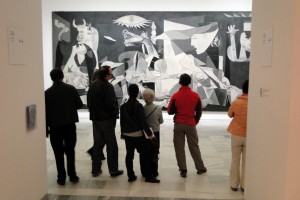Recently after a museum field trip, an ever resourceful colleague in Spanish was pleasantly surprised when her students reported having greatly enjoyed an activity she had assigned: “sitting still for 30 minutes staring at one painting, to see what new things they’d notice.” Given how accustomed we have become to scrolling quickly through images on social media (Facebook, Pinterest, imgur, Tumblr, Instagram, etc), she was justifiably worried that her students would become fidgety or bored. Instead, their curiosity and patience paid off: the paintings opened up to them.
There is something special about being in the presence of a work of art that is hard to express, but that differs markedly from the experience of viewing a reproduction. This is a key reason why language teachers travel with students, despite the staggering amount of extra work and responsibility it entails. It will always be worth the time and effort to experience art first-hand. New technologies, however, not only allow us instant access to a wealth of images from across the world we would have a hard time traveling to, they are increasingly able to help bridge the gap between in-person and virtual viewing. Take, for example, the “museum view” option offered on many museum websites that shows artworks in situ, giving us a greater sense of what a museum visitor sees.
Ultimately, we want our students to become astute observers through the widest variety of experiences we can offer them, both real and virtual. If circumstances rule out a field trip, another “low-tech” option is to bring in an actual artwork (perhaps a handicraft from a target culture) for students to observe, analyze and discuss before they tackle virtual artworks. In this way, students will be more likely to take into consideration the material aspects of the artworks that they will be viewing online. Starting with a low-tech approach (such as my colleague’s museum assignment) can really enhance our students’ online viewing experience and deepen their understanding of virtual images.
The chart below outlines the relative advantages of exploring artworks first-hand (low-tech) or virtually (high-tech). When discussing art with our students and creating activities, we would do well to keep these differences in mind so that we can make the most of the context in which they are viewing an artwork.
In-Person vs. Virtual Viewing*
|
With an actual work of art, you can: With a reproduction, you can’t: |
With an actual work of art, you can’t: With a reproduction, you can: |
|
See what size it is |
Change its size |
|
Shift your focus easily between the work as a whole and small details |
Blow up small details (and get closer than museum guards allow!) |
|
Get an accurate sense of color |
Modify the colors |
|
Get an accurate sense of texture |
Modify the technique/style |
|
See whether it has been restored |
Add or subtract parts of the image (interact and create) |
|
See it from different angles (or all sides if it is a sculpture) |
Rotate it to study its composition or other features |
|
Get a sense of its presence |
Compare works from opposite ends of the museum, from different collections, and from different periods |
|
Get a sense of your presence |
Collect and curate all the works you admire! |
*This chart is adapted from a presentation by Linda Andre (Baltimore Museum of Art, 1987).
Suggested further reading: The Google Cultural Institute’s Art Project has a wonderful set of tutorials for educators, allows you to create your own user gallery, and provides an annotated webography of the top art history websites.



